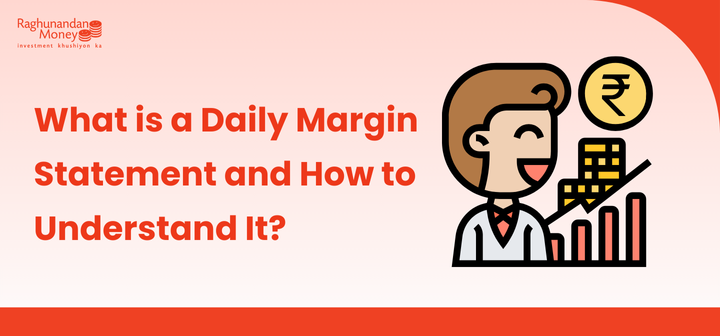What is a Daily Margin Statement and How to Understand It?
Post Date : May 16, 2025

A Daily Margin Statement is a report that provides clients with a detailed overview of their margin status. It includes the margins deposited (via fund transfers and pledged securities) and the margins blocked for open positions. The report is designed to keep traders informed about:
- The margin required by the exchanges for the positions taken or held.
- The availability of free margins to take new trades.
- Any margin shortfall that may lead to penalties, helping clients to maintain sufficient funds.
Understanding the Daily Margin Statement
1. Margin Available
This section shows the total available margin, including:
- Funds – Annex A: Displays the fund balance after reversing unsettled T-day (Trade day) credits and debits across Equity, F&O, and CDS (Currency Derivatives) segments. Since settlement follows a T+1 cycle, unsettled transactions are adjusted as follows:
Example:
o Mr. A has ₹1,00,000 in his account on Tuesday.
o He buys options worth ₹30,000 and Reliance shares worth ₹20,000.
o He sells Tata Motors shares worth ₹30,000.
o His closing balance is ₹80,000.
Fund Balance Calculation:
o T-Day Closing Balance: ₹80,000
o Add: Unsettled Debits (Options + Reliance): ₹50,000
o Less: Unsettled Credits (Tata Motors): ₹30,000
o Adjusted Fund Balance: ₹1,00,000
Annex A provides the detailed breakdown of these figures.
- Value of Securities – Annex B: Indicates the collateral margin received from pledging securities after applying the exchange-mandated haircut. Annex B contains the list and valuation of pledged stocks.
- Any Other Approved Form of Margins (EPI) – Annex C: Represents the Early Pay-in (EPI) margin. When shares are sold from the demat account and delivered to the exchange on the trade day, the full value of the sell transaction is counted as margin. Annex C provides the breakdown of such EPIs.
2. Margin Required
This section shows how much margin is required by the exchange for the trades taken. It includes the following sub-sections:
- Upfront Margin Required: The minimum margin that must be available in the account at the time of trade execution. It includes:
o Equity (EQ): Minimum Margin + Additional Margin
o F&O: SPAN + ELM (Extreme Loss Margin)
o CDS: SPAN + ELM
o MCX: SPAN only
- Consolidated Crystallised Obligation: Reflects the Mark-to-Market (MTM) loss or premium payable in each segment. These are due on a T+1 basis and are shown under this section.
- Delivery Margin Required: Applicable to ITM (In-the-Money) options held till expiry. This is charged by the exchange from four days prior to expiry and is calculated as a percentage of VAR + ELM + Adhoc margins of the underlying stock.
- Total End of Day (EOD) Margin Required: This is the sum of all the required margins (Upfront + Crystallised + Delivery) across all segments.
- Total Peak Margin Required: Displays the highest margin required during the day based on snapshots taken by the exchange.
3. Margin Collected
This section indicates how the available margin has been allocated across required margins.
- Upfront Margin Collected: Portion of margin collected from the client to meet upfront margin requirements.
- Consolidated Crystallised Obligation Collected: Margin collected to cover crystallised obligations (like MTM losses or option premium) after allocating funds to upfront margin.
- Delivery Margin Collected: Portion of the margin collected to cover delivery margin obligations.
- Total EOD Margin Collected: Sum of all margins collected by the end of the trading day.
- EOD Excess/Shortfall: Difference between the total available margin and EOD margin required. A negative value implies a margin shortfall.
- Total Peak Margin Collected: Total margin collected at the time of the day when the margin requirement was at its peak.
- Peak Excess/Shortfall: The difference between the peak margin available and the peak margin required. A shortfall here may attract penalties.
4. Indicative Peak Snapshot Time
This refers to the time of the highest margin requirement during the trading day, as per the snapshots taken by the exchange. It is indicative, as it reflects the time when
the broker (RMoney) receives the snapshot, not the exact time the exchange recorded it.
Did You Know?
Clients can add funds on T+1 day to avoid penalties for any shortfall in:
- Consolidated Crystallised Obligation
- Delivery Margin
- Additional Margin (in Equity segment)
Monitoring daily margin statements helps ensure sufficient margins and reduces the risk of auto square-off and penalties.
Need Help?
Contact RMoney at 0562-4266600 / 0562-7188900,
Email: askus@rmoneyindia.com

Stock Trading Now trade in ₹9 Per Order or ₹ 999 Per Month Plans.
Future & Options Access F&O contracts with advanced tools for hedging and speculation.
Currency Trading Trade in major currency pairs and manage forex exposure efficiently.
Commodity Trading Diversify Trading with MCX & NCDEX by Trading in Gold, Silver, Base Metals, Energy, and Agri Products.
Margin Trading Funding Boost your buying power with upto 5X, Buy now Pay Later
Algo Trading Back test, Paper Trade your logic & Automate your strategies with low-latency APIs.
Trading View Leverage Trading View charts and indicators integrated into your trading platform.
Advanced Options Trading Execute multi-leg option strategies with precision and insights.
Stock Lending & Borrowing Earn passive income by lending stocks securely through SLB.
Foreign Portfolio Investment Enable NRIs and FPIs to invest in Indian markets with ease and compliance.
IPO Invest in upcoming IPOs online with real-time tracking and instant allotment updates.
Direct Mutual Funds 0% Commissions by investing in more than +3500 Direct Mutual Fund Scheme.
Corporate FDRs Earn fixed returns with low-risk investments in high-rated corporate fixed deposits.
Stocks SIPs Build long-term wealth with systematic investment plans in top-performing stocks.
Bonds & NCDs Access secure, fixed-income investments through government and corporate bond offerings.
Depository Services Safely hold and manage your securities with seamless Demat and DP services with CDSL.
Journey Tracing our growth and milestones over time.
Mission & Vision Guided by purpose, driven by long-term vision.
Why RMoney Platform Smart, reliable platform for all investors' needs.
Management Experienced leadership driving strategic financial excellence.
Credentials Certified expertise with trusted industry recognition.
Press Release Latest company news, updates, and announcements.
Testimonials Real client stories sharing their success journeys.
7 Reasons to Invest Top benefits that make investing with us smart.
SEBI Registered Research Trusted insights backed by SEBI-compliant research.
Our Technology Advanced tools enabling efficient online trading.
Calculators Access a suite of smart tools to plan trades, margins, and returns effectively.
Margin Calculator Instantly check margin requirements for intraday and delivery trades.
MTF Calculator Calculate MTF funding cost upfront to ensure full transparency before placing a trade.
Brokerage Calculator Know your exact brokerage charges before placing any trade.
Market Place Explore curated investment products and trading tools in one convenient hub.
RMoney Gyan Enhance your market knowledge with expert blogs, videos, and tutorials.
Performance Tracker Track our research performance with full transparency using our performance tracker.
Feedback Share your suggestions or concerns to help us improve your experience.
Downloads Access important forms, software, and documents in one place.
Locate Us Find the nearest RMoney branch or service center quickly.
Escalation Matrix Resolve issues faster with our structured support escalation process.
Back Office Log in to view trade reports, ledger, and portfolio statements anytime.
Account Modification Update personal or bank details linked to your trading account.
Fund Transfer Transfer funds instantly online with quick limit updation to your trading account.
Bank Details View our registered bank account details for seamless transactions by NEFT, RTGS or IMPS.
How to Apply IPO Step-by-step guide to apply for IPOs using your trading account.
RMoney Quick Mobile App Trade on-the-go with our all-in-one mobile trading app.
RMoney Quick login Quickly access your trading account through the RMoney Quick web-based trading.
RMoney Rocket Web Version Experience powerful web-based trading with advanced tools for algo traders.
RMoney Rocket Mobile Version Trade anytime, anywhere with our feature-rich mobile trading platform.












